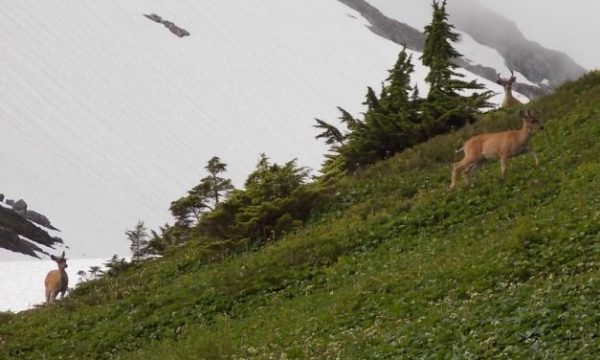
Relatively mild winters over the past decade have pushed deer populations in the Sitka area to record highs — and maybe even over the biological carrying capacity of the land in some places.
In addition to deer, the bear population is increasing due to the mild climate and — as Sitkans are more than aware — bears are remaining out and active longer than ever.
Simply put, humans are outnumbered. Not only are humans not the majority mammal population on Admiralty, Baranof, and Chichagof islands — they’re not even in the running.
Fish & Game management biologist Steve Bethune reported on local wildlife populations to the Sitka Advisory Committee in November.
He gave numbers for Sitka black-tailed deer that are just staggering.
“Our population objective for Game Management Unit 4 is 125,000 deer — unit-wide — and I’m fully confident we’re above that number,” he told the committee.
Could he be more specific? Someone on the committee asked. Bethune gave it his best shot.
“This is a real scientific estimate,” he said. “Yeah… lots.”
Game Management Unit 4 — or GMU4 — is nicknamed the “ABC Islands.” That’s for Admiralty, Baranof, and Chichagof. Sitka has the largest concentration of humans on the ABC’s, with a total population of something just over 11,000. So deer outnumber humans in the unit by a factor of about 12.
Bethune attributes the boom in deer population to mild winters since the “Snowpocalypse” of 2007-8. But in biological terms, huge deer numbers are not necessarily a great thing.
“We have a lot of deer on the landscape right now,” Bethune said. “We’re probably reaching — or exceeding — carrying capacity in some places. You just see the vegetation hammered in some watersheds.”
Has the boom been a boon to hunters? Not so much, it turns out. The maximum harvest level for the unit established by the Board of Game is 11,000 deer, which Bethune thinks is unrealistic. Still, area hunters are only expected to take about 5,000 deer this season — which is pretty average.
Bethune says mild winters give deer the advantage over some of our conventional, island hunting tactics.
“If I had to speculate, I would say it’s because we’ve had such a lack of snow the last couple of years that the deer aren’t getting driven down to the beaches,” said Bethune. “And so even though there are a lot of deer, you actually have to get out of your boat and walk around the woods.”
But there aren’t just deer walking around those woods. The ABC Islands are home to some of the planet’s highest densities of brown bear. Although the last formal study of brown bear population in the Unit was in 2002, biologists update the number annually using a variety of tools. Bethune says it now stands at 4,300 brown bear — and it seems there were more than a few of them roaming around town this fall.
“We had a pretty significant blip in bear activity in the Sitka area in mid- to late-October,” Bethune said. “It seems like it’s on the downhill slide right now. I’ve been watching it and keeping my fingers crossed. Those bears should be going into the dens anytime soon, if not already.”
That magical day when Sitka is bear-free for the winter still hasn’t arrived. The two weeks before Thanksgiving saw a number of bear incidents — some chicken coops robbed, and even a dog killed in the Indian River neighborhood. Bethune says it’s likely not so much the extended mild temperatures that have kept bears active, but the abundance of food — in the wild and in town. There were no dangerous encounters with residents however, and Bethune is glad that none of the bears had to be destroyed. Nevertheless, as winter arrives in Southeast, he cautions residents that bears can be seen any time of year.
One other species is booming: Mountain goats. Bethune estimates that there are almost 2,000 of the elusive, alpine-dwellers on Baranof Island now — a record high since their introduction in 1923. Unlike deer, however, mountain goats are not exceeding carrying capacity. In fact, their range is expanding in unexpected ways.
“And I am starting to get reports of goats in weird places,” said Bethune, “which indicates to me that young billies are branching out and looking for new habitat. We had a goat wandering around on the shores of Redoubt Lake this summer. We had a goat on Green Lake Road this fall. We had some campers at the Allan Point Cabin on Halleck Island report a mountain goat — and I believe it was a credible report — on the beach. They stepped out on the porch of the cabin, and there was a goat.”
Bethune offered no insight on what may have inspired the mountain goat to swim to Halleck Island — or how an animal at home on the highest, steepest, most desolate ice fields in Southeast Alaska even learned to swim.
Robert Woolsey is the news director at KCAW in Sitka.




